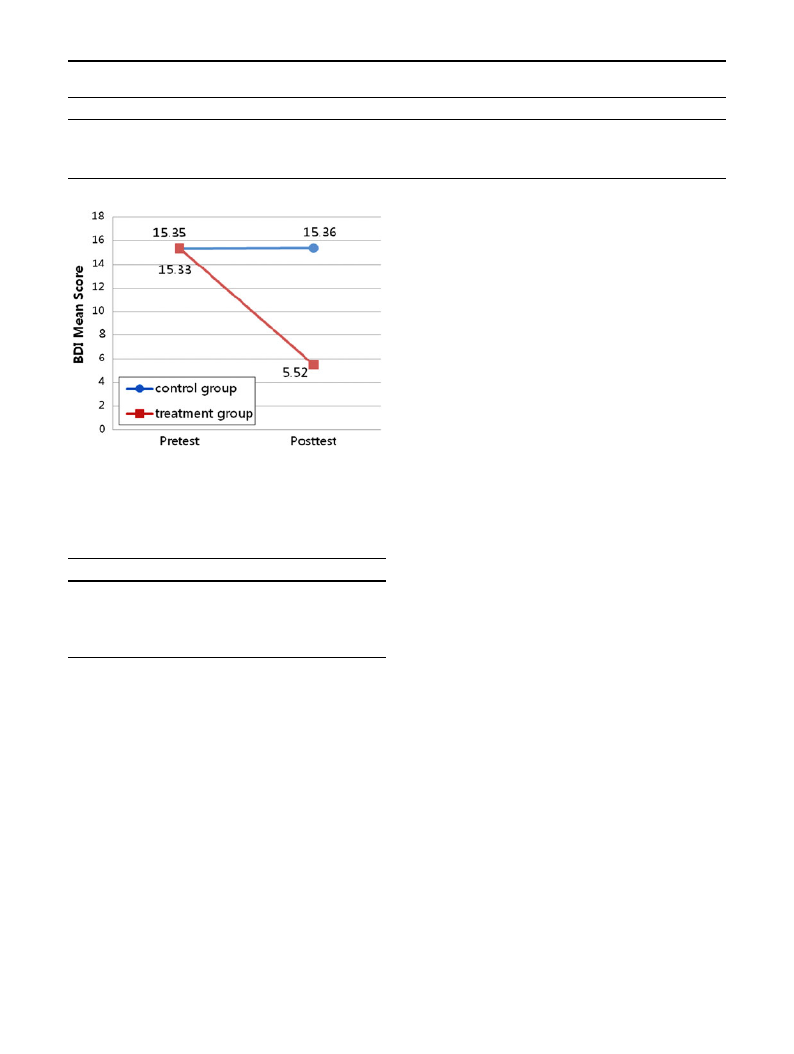
Environ Health Prev Med (2012) 17:73–76
DOI 10.1007/s12199-011-0215-0
SHORT COMMUNICATION
The influence of forest therapy camp on depression in alcoholics
Won Sop Shin • Chang Seob Shin • Poung Sik Yeoun
Received: 8 October 2010 / Accepted: 30 March 2011 / Published online: 19 April 2011
Ó The Japanese Society for Hygiene 2011
Abstract
Objectives To evaluate the effect of a forest experience
on the levels of depression of alcoholics.
Methods Prior to the study, 92 alcoholics were divided
into treatment and control groups. During the summer of
2009, the treatment group participated in a series of forest
therapy programs, while the control group followed their
normal daily routines. Both groups were re-tested upon
completion of the program by the treatment group and the
depression levels compared.
Results There was a significant improvement in the
depression level of alcoholics who had participated in the
forest camp program (treatment group). Those participants
in their 40s who had severe levels of depression at the
beginning of the program showed the most significant
improvement during the program experience.
Conclusion The forest therapy camp experience can
considerably reduce and ameliorate the depression levels of
alcoholics.
Keywords Alcoholics Á BDI Á Depression Á
Forest experience Á Healing program
Introduction
In modern society, individuals spend most of their time
drawing on their own resources to deliberately direct
attention or pay attention to various issues [1]. The infor-
mation- and high technnology- based demands placed upon
W. S. Shin (&) Á C. S. Shin Á P. S. Yeoun
Department of Forest Resources, Chungbuk National University,
12 Gaesin-dong, Heungduk-ku, Cheongju 361-763, Korea
e-mail: wonsop.shin@gmail.com
most people in everyday life are resulting in mental fatigue.
In contrast, natural environments, such as forested land-
scapes, seem to effortlessly engage people’s attention,
allowing them to be in a place where they do not have to
actively pay attention. For this reason, Kaplan [1] suggests
that contact with nature has a restorative function. Several
investigations support Kaplan’s theory, indicating that
exposure to a forest environment can effectively reduce
stress [2, 3].
Alcoholism is a major psychological problem in South
Korea. Recent changes in the socio-economic status of
many South Koreans have resulted in major social and
health problems related to alcohol (mis)use. There is sub-
stantial evidence that heavy alcoholism is associated with
the development of psychological symptoms, such as
depression and anxiety. In the last two decades, the body of
knowledge on the physical and psychological aspects of
alcoholism has improved considerable. Empirical studies
investigating the relationships between alcoholism and a
variety of concerns, such as depression, anxiety, low self-
esteem, and difficulty with intimate relationships, have
become increasingly more numerous [4]. Among these are
empirical studies on the psychologically restorative effects
of the direct effect of forest environments, including wil-
derness areas [5], urban forest parks [6], nearby trees and
grassy areas close to public housing [1], and even the view
of a forest through windows [7]. If contact with forest is
attentionally restorative, how then might an attentional
restorative program mitigate the depressive symptoms of
alcoholics? The study reported here was designed to
investigate the relationship between the experience of
alcoholics participating in a restorative forest program and
the effect of this program on their depression levels. Our
interest was in the degree of changes in self-reported
depression after completion of a 9-day forest program.
123

74
Environ Health Prev Med (2012) 17:73–76
Methods
Study areas
Study subjects
The subjects for this study consisted of 92 adult alcoholics
enrolled in the Korean Alcohol Research Center in
Chungbuk Province, South Korea. The Korean Alcohol
Research Center is a national inpatient alcohol rehabilita-
tion institute founded in 1997. All participants were
chronic alcoholics whose drinking problems were severe
enough to necessitate inpatient treatment. Only participants
who were detoxified and oriented, but had not yet begun
any psychological treatment, were included in the sample.
Participants were excluded if they met criteria for any
psychoactive substance dependence besides alcohol or if
they had a severe medical illness. All 92 participants who
complied with the above inclusion criteria consented to
participate. Informed consent was obtained from all par-
ticipants on the basis of a procedure that is officially
approved by the Research Ethical Committee of Chungbuk
National University. The participants were randomly
assigned to a treatment and control group, respectively.
This random assignment process resulted in 47 treatment
participants and 45 control participants.
To examine whether there were any differences in the
characteristics of the alcoholics in the two groups, we
initially performed several t tests. As shown in Table 1,
there were no statistically significant differences in the age,
education, and alcohol dependence levels between the
participants of the two groups.
Instruments
The Beck Depression Inventory (BDI) was employed to
determine the depression levels of the alcoholics, as this
was a major dependent research variable in this study. The
BDI is a self-report measure of 21 items in a multiple
choice format. Score can range from 0 (no depression) to
63 (high depression). This measurement tool has been used
extensively in clinical research and demonstrates validity
and reliability.
The 9-day forest healing camp was conducted and data for
this study were collected from Saneum Recreational Forest
in South Korea. A primary reason why this forest was
selected for the study is that the recreation forest was
designated as a ‘‘model forest for human health’’ by the
Korea Forest Service.
The study area (Saneum Recreational Forest) is located
in Kyungggi Province, about 80 km away from Seoul, the
capital of South Korea. Saneum Recreational Forest has
2,140 ha of forest area mainly composed of oaks and pine.
The numbers of visitors was 76,559 in 2007.
Data collection
To investigate the efficacy of the forest experience on the
depression levels of the alcoholics, a 9-day forest therapy
program was designed and conducted during the summer
of 2009. The forest healing program was designed to meet
the following objectives: (1) to provide exercises repre-
sentative of the forest therapy programs described in the
literature, specifically those exercises prescribed to aid in
psychological development; (2) to be representative of
Kaplan’s theory denoting the mechanisms of psychologi-
cal benefits from forest experiences [1]; (3) to accompany
the application of other therapies, such as meditation,
exercise, and counseling. Three treatment sessions were
developed for the treatment (experimental) group. Each
session of the camp was designed to achieve different
goals. A summary of each session of the camp is pre-
sented in the Table 2. As it can be seen from the Table 2,
each session of the camp was designed to achieve dif-
ferent goals.
A set of questionnaires, including a personal-profile and
the Korean version of the BDI, was administered and
completed by the participants in order to collect baseline
data during the orientation at the first session of the camp.
For comparative data collection, the same type of ques-
tionnaire was distributed to each participant at the end of
the final session of the camp.
Table 1 Background characteristics on the treatment and control alcoholics participants
Characteristic
Treatment group (n = 47)
Control group (n = 45)
t
Probability
Age
Educationa
Alcohol dependence levelb
44.66 ± 3.90
13.26 ± 2.73
37.28 ± 7.22
45.87 ± 3.85
13.27 ± 2.51
37.17 ± 6.71
-1.492
-0.021
0.068
0.139
0.984
0.946
Values for treatment and control groups are presented as the mean ± standard deviation (SD)
a Years of formal education
b Based on scores of the Alcohol Dependence Scale (ADS). Total scores can range from 0 to 47, with the higher the value, the greater the
dependence
123

Environ Health Prev Med (2012) 17:73–76
Table 2 Summary of forest therapy camps
Session
Duration (days)
Goal
First
3
Second
3
Third
3
Interacting with nature/forest
Challenge
Self-introspection
75
Activities
Nature–game, nature–interpretation, etc.
Mountain-climbing, tracking, orienteering, etc.
Nature-meditation, Counseling in forest environment, etc.
3.89 years); gender (84 males, 8 females); education
(3 elementary school graduates, 6 junior high school grad-
uates, 45 high school graduates, 38 college or university
graduates); marital status (33 unmarried, 35 married,
24 divorced).
Forest therapy camp experience and improvement
in the depression level of the alcoholics
Fig. 1 Pre-test–post-test Beck Depression Inventory (BDI) mean
scores for the treatment and control groups
Table 3 Differences in the change in depression scores (Beck
Depression Inventory) between the pre- and post-test based on a
number of respondents’ personal variables
Variables
df
F values
Probability
Age
3
Education
3
Marital status
2
Base-line depression levels
2
3.07
0.37
0.65
14.88
0.041
0.775
0.529
0.001
Statistical analysis
Statistical analysis was performed using Windows SPSS (ver.
15; SPSS, Chicago, IL). The descriptive analysis was pre-
sented as means and standard deviations (SD) for continuous
measures and as frequencies for categorical measures. Group
comparisons for outcome measures were conducted using
t tests and analysis of variance (ANOVA) for continuous
measures and v2 tests for categorical measures.
Results
Socio-demographic characteristics of the subjects
The principle demographic characteristics of the 92 par-
ticipants taken into consideration were: age (mean 45.26 ±
Scaled data on ratings of depression according to the BDI
were collected prior to the forest camp and upon comple-
tion of the forest camp by the treatment group. The change
from pre-test (baseline) to post-test is presented in scale
score terms, and the mean difference was tested for
statistical significance using a two-tailed t test. The mean
pre-test scores (BDI) before the first session of the forest
program were 15.35 (treatment group) and 15.33 (control
group). There was no statistically significant difference
between the two groups. According to clinical criteria in
Korea, BDI scores between 14 and 20 are classified as
moderate depression. By the end of the forest camp, the
mean post-test score (BDI) for treatment group was 5.52, a
score that indicates no depression according to the clinical
criteria used in South Korea. In comparison, the mean post-
test score (BDI) for the control group was 15.36. For the
treatment group, the mean difference in BDI score between
pre- and post-forest program experience was 9.83.
According to the t value, this difference was statistically
significant (t = -6.27; p B 0.001). Therefore, we con-
cluded that the forest program experience decreased the
depression levels of the participating alcoholics (see
Fig. 1).
In addition to comparing the BDI scores, we also ana-
lyzed a number of relatively objective variables (i.e., dif-
ficulty in falling and difficulty in staying asleep). The result
of the v2 analysis, which was based on self-reporting,
indicated that, relative to alcoholics in the control group,
the alcoholics with forest camp experience had less diffi-
culty in falling asleep (p B 0.001) and had less difficulty in
staying asleep (p B 0.009).
To investigate the role of the personal variables, such as
gender, education levels, marital status, and base-line
depression levels, a series of ANOVA was performed. As
can be seen from Table 3, alcoholics in their 40s showed
the greatest improvement in BDI scores (11.09), followed
123

76
Environ Health Prev Med (2012) 17:73–76
by participants in their 30s (6.83) and 50s (3.11). The
severity of the depression levels of the alcoholics before
the forest camp played a significant role on their depression
levels upon completion of the forest program. Alcoholics
with higher depression levels before the program tended to
improve their depression levels by completion of the forest
program more so than those who started with lower
depression levels. However, the education level and marital
status of the alcoholics did not play any significant role in
the improvement of their depression levels.
Discussion
In this study, we examined how a forest program experi-
ence can be beneficial to alcoholics and how it can improve
their depression levels. The study cohort comprised 92
alcoholics who were detoxified and oriented, but who had
not yet begun any psychological treatment. The results
indicate that the forest program experience played a
significant role in the amelioration of the depression levels
of these alcoholics. Consistent with previous research on
nature’s ability to improve mood and reduce stress, pro-
duce positive feelings, boost feelings of energy, have
positive psychological effects, and increase healing [1–3],
we found that the depression levels of the participating
alcoholics decreased after their forest program experiences.
The forest provides a refuge from the artificial and man-
made constructions that exist in our society, and the forest
environment clearly occupies a prominent position among
most individual’s favorite places. Moreover, the forest
environment seems to be particularly closely associated
with restorative outcomes. The feelings most frequently
associated with a desirable location and its contribution to
psychological well-beings are relaxation, calmness, and
comfort, with happiness, enjoyment, and excitement being
frequently mentioned. Because people tend to forget their
worries and reflect on personal matters more so in the
forest, it has been suggested that this environment is vital
for reducing depression levels [6].
The findings in this study provide strong evidence for
the potential effect of the forest environment on depression
levels, a topic that has been largely unexplored. Further
studies should include different types of participants
undergoing different types of experiences at different
locations, a wider inventory of disposition items, and
variables that define different aspects and components of
the forest experience benefits, including descriptive infor-
mation on the benefits of forest.
References
1. Kaplan S. The restorative benefits of nature: toward an integrative
framework. J Environ Psychol. 1995;15:169–82.
2. Ulrich RS, Simons RF, Miles MA. Effects of environmental
simulations and television on blood donor stress. J Archit Planning
Res. 2003;20:38–47.
3. Hartig TH, Evans GW, Jamner LD, Davis DS, Garling T. Tracking
restoration in natural and urban field settings. J Environ Psychol.
2003;23:109–23.
4. Kashubeck S, Christensen SA. Parental alcohol use, family
relationship quality, self-esteem, and depression in college
students. J Coll Stud Dev. 1995;36:431–43.
5. Shin WS. Self-actualization and wilderness attitudes: a replication.
J Soc Behav Pers. 1993;8:241–56.
6. Shin WS, Kwon HK, Hammitt WE, Kim BS. Urban forest park use
and psychological outcomes: a case study in six cities across South
Korea. Scand J For Res. 2005;20:441–7.
7. Shin WS. The influence of forest view through a window on job
satisfaction and job stress. Scand J For Res. 2007;22:248–53.
123
